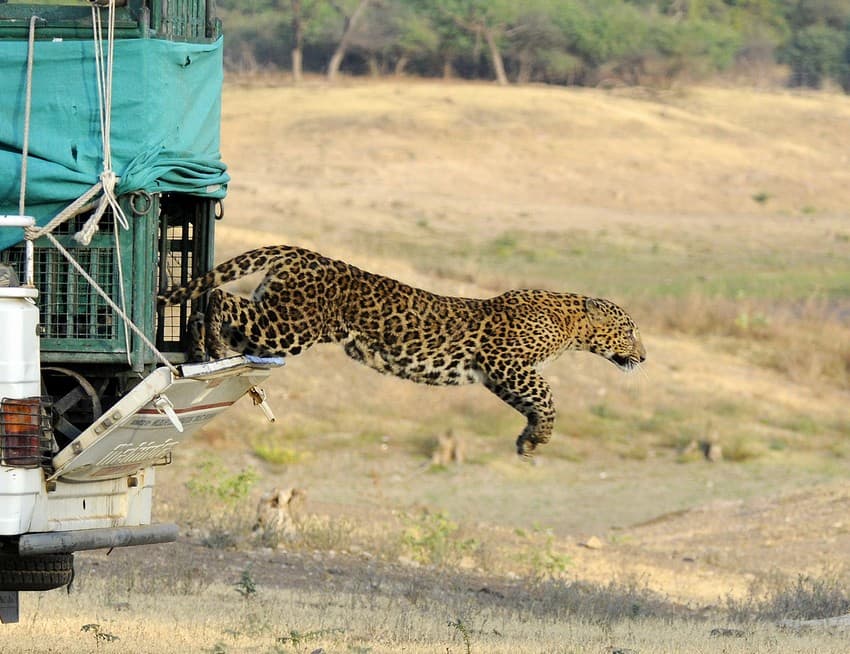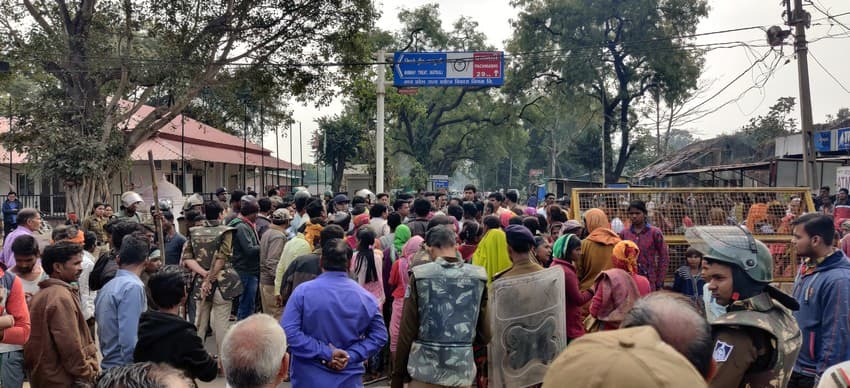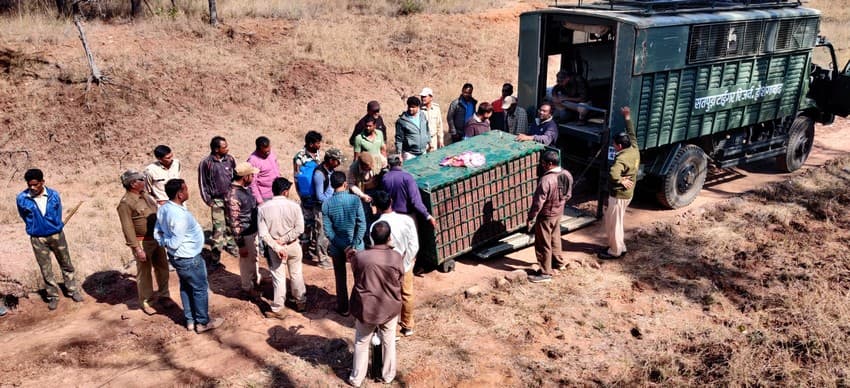An expert’s take on wildlife rescue in India
What is it that draws people to scenes of accidents, crimes, and calamities like moths to flames? Those that gather to spectate a person or animal in distress seem to be in a trance so much so that any amount of warnings and pleas to disperse them seem to be in vain. In such moments, individual persons seemingly cease to exist, and crowd takes on a persona of its own. A mob is born. Individual dynamics don’t apply anymore. Crowd dynamics are at work.

A rescued leopard being released in Gir, Gujarat. Photo credit: Dr. Anish Andheria
The recent (December 2020) tragic tale of the wild gaur that had strayed into the city of Pune, possibly from the nearby Mulshi and Tamhini forests, and died after a rescue operation went awry due to the unruly crowd that hampered the rescue efforts of the forest officials, begs, once again, to address this troubling matter. Many operations have been impeded in the past due to unnecessary disturbance created by bystanders – people gathering to watch, heckle, and photograph, and some to merely make an ugly display of machoism and false bravado. For the cornered and disoriented animal in question, the trauma and shock of the clamour around it could be irrevocably scarring and more often than not leads to trauma and death. The unfortunate gaur, the primary post-mortem reports reveal, suffered from exhaustion and stress that led to cardiovascular failure, shock and eventual death. And as for rescue squads from the Forest Department, juggling the difficult task of rescuing the panicked and potentially dangerous wild animal along with managing an irate crowd is phenomenally tough. Not to mention, they risk their own lives in the process. Figuratively, they find themselves between rock and a hard place.
Human-wildlife conflict is one of the biggest challenges that wildlife and conservation face today, and it is only getting worse. Wildlife conservation is already faced with multitude of obstacles and unrelenting challenges in a world where biodiversity and climate destruction are outpacing the efforts to protect them. Unnecessary actions on the part of civilians that hamper wildlife rescue operations set conservation back a little more each time.
Conservation and Science Writer with Wildlife Conservation Trust (WCT), Purva Variyar, speaks to Dr. Prashant Deshmukh, Wildlife Veterinarian with WCT who heads the organisation’s Human-Wildlife Interface Management (HWIM) vertical. They discuss what it takes to execute a wildlife rescue operation, challenges faced by the forest personnel, the challenge of crowd management, and how civilians should react and act in such an event. Dr. Deshmukh and his team have been providing crucial support and assistance to the Madhya Pradesh Forest Department in mitigating human-wildlife conflict and conducting wildlife rescue operations for the past six years.
Q: Prashant, you have wound up at the epicentre of several human-wildlife conflict scenarios that involved wild animal rescues. Could you briefly tell the readers about what it takes for the forest personnel to conduct a rescue operation?
Commitment, confidence, and common-sense are the most integral aspects of any rescue operation. These operations are most often conducted in a hostile environment and are physically and psychologically demanding. In the absence of commitment, one is likely to give-up instead of striving towards achieving the objectives of the rescue operation. The situations like these are also very fluid and dynamic in nature. The confidence to deal with fluctuating scenarios, without falling into a trap of hasty decisions, is crucial for an operation to be successful. The solutions are at most times simple. Thus, one needs common sense to make the most of what the situation has to offer and use it to one’s advantage.
To give an example, think of a situation where a bear is stranded on a tree in a village which is close to the jungle. This situation does not demand physical or chemical capture. Best solution would be to disperse the crowd and wait till end of day for the bear to come down and walk away. As the animal perching on a tree is not a threat to any human life, the best solution lies in waiting. Often simplicity eludes us when one is in pursuit of solutions to complex situations.
Q: Several parts of India, especially those which abut wildlife habitats, are already rife with intensifying human-wildlife conflict. Resulting economic and personal hardships are a facet of people’s lives there. Could you elaborate?
Loss to life and property are among the quantifiable hardships that people have to incur by the virtue of being close to the forest. To add to it is the intangible cost of the psychological stress of having to cohabit with wild animals whose behaviours are difficult to understand and predict.
While people in Chandrapur district in Maharashtra are witnessing growing number of interactions with large carnivores such as tigers, in north Bihar the problem of snakebites and retaliatory killing of snakes is a huge issue; while human-leopard conflict in Uttarakhand is ballooning, human-gaur interactions are also increasing in the Western Ghats. Human-elephant conflict (HEC) has intensified to tumultuous levels in several states in central, east and north-east India and has emerged as one of the most potent conservation challenges of our time.
Q: But, in other places, including urban regions which see relatively rarer instances of interactions with wildlife, they do occur and such encounters are only increasing in frequency. There are likely to be more Pune-like instances in the future. How should civic authorities in such cities better equip and prepare for it?
Since the instances of human-wildlife interactions in urban settings are sporadic events, the cities must have an urban wildlife management plan in place. When wildlife enters an urban space, probability of human casualty and damage to property is high. The Forest Department, which are guardians of wildlife, have limited resources. Hence, the rescue operations have to be a collaborative effort between the Forest Department, police, and city administration.
Physical resources such as man-power, vehicles, barricades, etc. as well as geographical know-how, movement of crowd across the urban space, understanding of city infrastructure are some of the things that will be fundamental for an operation in urban spaces to be successful. Forest Department alone will not be able pull through the resources required for such an operation.
To give an example, a situation in which leopard perched a few meters away from an electricity line might demand cut-off of supply for a few hours for safely conducting the rescue operation as well as police personnel will be important for managing crowds. Involvement of civil administration is crucial in such scenarios.

Joint staff of police and Forest Department managing the crowd that has gathered post an unfortunate human casualty caused as result of human-tiger conflict in Madhya Pradesh. Photo courtesy: Dr. Prashant Deshmukh/WCT
Q: More often than not, spectating crowds of people lead to botched rescue operations of wild animals that stray into human-dominated spaces. Why, according to you, do people tend to behave erratically in crowds at such times? What is the psychology behind this?
Crowds are erratic by nature, irrespective of the reason for which they have gathered. We hear of stampedes at public gatherings frequently. In an unforeseen situation, when there is an absence of leadership or a clear plan of action, a crowd usually will try to fill in the vacuum and assume the role of a problem-solver. In the past, individuals with leadership aspirations or political motivations have come to us mid-operation, asking us to give them charge of resolving the situation. Given that wild animals are not a common feature of an urban landscape, there is an added novelty factor to seeing one, which might add further fuel to the fire.
Q: Could you explain what an ideal rescue operation looks like? Which civic bodies are supposed to work in tandem? Whom does the responsibility of crowd management fall upon?
An ideal rescue operation is when there is no human injury/causality and the animal is out of distress without being stressed further and no harm occurs to anyone. Forest Department, animal husbandry, zoological garden (if any), police, civil administration, municipal corporation are some of the civic bodies that should work in tandem in such a situation. In an urban setting, the burden of crowd management has to be borne by the police department, preferably riot-control police. This is because human life is directly in danger and therefore it is a law and order situation. The crowds can be very big and Forest Department does not have staff strength to deal with such a big crowd. Also, the forest staff is not equipped, trained or experienced in crowd management.
Q: What is the state of Forest Department rescue squads in India? How can they be better equipped and supported to manage conflict and rescue scenarios?
The state of rescue squad varies depending on nature and frequency of rescue operations they undertake. States such as Madhya Pradesh and Maharashtra are better equipped to tackle carnivore conflict, whereas Karnataka which predominantly faces elephant conflict, is better equipped to deal with those. The measures taken to equip the rescue squads is often in reaction to rising conflict. There is a lack of larger policy to dictate uniform, basic composition of a rescue squad and the wellbeing of people constituting rescue teams.
From our own observations and experience, the outcome of any wildlife rescue operation is directly dependent on equipment and protective gear at the disposal of rescue teams and their general motivation. Unfortunately, the forest staff across various state Forest Departments in India are poorly equipped, under a lot of pressure, and lack the necessary training, gear including uniforms and public address systems which are extremely crucial for successful implementation of wildlife rescue operations. The importance of amenities such as, let’s say uniforms, are poorly understood and underestimated. Rescue sites are often crowded due to presence of onlookers. Wearing distinctly different uniforms helps to differentiate rescue team from the crowd, build team spirit, exert authority in the minds of onlookers and shield the team from any hostile behaviour from local communities.
Policies that prioritise providing the Forest Departments with necessary funding for essential training, equipment, and critical gear to improve efficiency and safety of the team members, should be passed.
Q: Though there are SoPs circulated by Forest Departments, and policies laid down by the MoEFCC, which list out reasons and actions for the various stakeholders including local civilians, not everyone knows about them. Could you simply enumerate for the readers, what to do and not do in such an event?
If you encounter a wild animal in human habitation, reach to the place of safety. Call and inform emergency number like 100. Do not approach/chase/heckle/harass the animal. Do not circulate the information on WhatsApp or any social media except for the people who might probably be at the risk in vicinity. Do not interfere/participate in an ongoing rescue operation unless asked to do so.
Most importantly Stay away.
Q: Lastly, could you enlighten us about the psychological and physiological impact straying into human-occupied spaces and encountering hostile behaviour has on a wild animal? People tend to forget that there is a frightened, disoriented animal at the centre of all the man-made chaos.
Animal when strayed, is distressed and considers everyone to be a threat. Imagine waking up in the middle of a jungle, with a thousand gaurs circling and charging at you. That’s how a gaur feels when he is encircled by a sea of humans. Like most animals, we gain strength in numbers and it is important that we don’t use that strength against the already-scared animal.
A rescue operation that leads to capture and translocation of the animal, largely because of presence of an erratic crowd, can have lasting effect on the animal even after it is released back into the wild. That animal will have to reorient itself and will face threats in the process of doing so.

A tiger rescue operation underway near Satpura Tiger Reserve, Madhya Pradesh, in March 2020. With appropriate crowd management, a rescue operation can yield a positive outcome, such as this one did. Photo courtesy: Dr. Prashant Deshmukh.
We have to contend with the rising human population and urbanisation, and as forest cover shrinks and natural habitats vanish, man-animal interface will only grow. And now is the time to understand how best to deal with such interactions so as to minimise damage on both sides – people and wildlife. And as civilians, how we behave around a wild animal that has strayed into human habitation, how we cooperate with Forest Departments’ rescue teams which risk their lives and limbs, so as to cause as little stress and trauma to the beleaguered animal as well as ourselves, is extremely crucial.
——————————————————————————————————————————————————————
About the author: Purva Variyar is a conservationist, science communicator and conservation writer. She works with the Wildlife Conservation Trust and has previously worked with Sanctuary Nature Foundation and The Gerry Martin Project.
Disclaimer: The author is associated with Wildlife Conservation Trust. The views and opinions expressed in the article are her own and do not necessarily reflect the views and opinions of Wildlife Conservation Trust.
——————————————————————————————————————————————————————
Your donations support our on-ground operations, helping us meet our conservation goals.
——————————————————————————————————————————————————————
Related Links
- Of Alien Origins And Earthly Splendour
- Team
- Psychology Fellowship
- In Hostile Territory
- Bajaj Auto Limited

